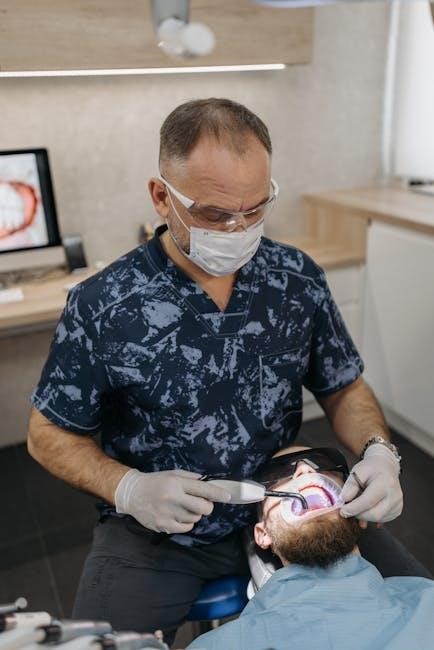
after fluoride treatment instructions
Immediate Post-Treatment Instructions
After fluoride treatment, wait 30 minutes to an hour before eating or drinking. Avoid hot beverages and rinsing. Stick to soft foods and do not brush or floss immediately.
1.1 Waiting Period Before Eating or Drinking
After fluoride treatment, wait 30 minutes to 1 hour before consuming food or drinks. This allows the fluoride to absorb into the enamel effectively. Consuming anything too soon may reduce treatment efficacy or cause discomfort. Stick to soft, non-hot foods initially and avoid hard or crunchy items to ensure optimal results.
1.2 Avoiding Hot Beverages and Rinsing
Avoid hot beverages immediately after fluoride treatment to prevent discomfort and reduce effectiveness. Do not rinse your mouth for at least 30 minutes to allow proper absorption. Hot liquids can interfere with the fluoride bonding to enamel, while rinsing may wash away the treatment. Stick to lukewarm water if needed during this period.
Dietary Recommendations
After fluoride treatment, stick to a soft food diet for the remainder of the day. Avoid hard, crunchy, or staining foods/drinks. Opt for lukewarm water to stay hydrated.
2.1 Soft Food Diet
After fluoride treatment, opt for a soft food diet to avoid damaging the treated teeth. Choose foods like yogurt, mashed potatoes, and soft-cooked vegetables. Avoid chewing or biting forcefully for at least 24 hours. This helps ensure the fluoride adheres properly, enhancing its effectiveness in protecting your teeth.
2.2 Avoiding Hard or Crunchy Foods
Refrain from consuming hard or crunchy foods such as nuts, chips, or raw vegetables for at least 24 hours post-treatment. These can dislodge the fluoride coating, reducing its protective benefits. Opt for gentle, non-abrasive options to ensure the treatment remains effective and your teeth stay protected. This precaution supports optimal dental health outcomes.
2.3 Staying Hydrated with Lukewarm Water
Drink lukewarm water to stay hydrated after fluoride treatment. Avoid hot beverages for a few hours to prevent discomfort or dislodging the fluoride. Water helps maintain moisture without interfering with the treatment’s effectiveness, ensuring your teeth remain protected and comfortable throughout the healing process. This practice supports overall oral health and treatment success.
2.4 Avoiding Staining Drinks
To prevent staining and ensure the fluoride treatment’s effectiveness, avoid dark-colored beverages like coffee, tea, and red wine for at least 24 hours. These liquids can interfere with the treatment and potentially discolor your teeth. Stick to clear or lukewarm water and avoid sugary drinks to maintain optimal oral health and treatment results.
Oral Hygiene Practices
After fluoride treatment, resume brushing and flossing gently 4-6 hours later. Use fluoride toothpaste as directed to maintain treatment effectiveness and promote oral health.
3.1 Resuming Brushing and Flossing
After fluoride treatment, wait 4-6 hours before brushing or flossing. Resume gentle oral hygiene practices with a soft-bristled toothbrush and fluoride toothpaste. Avoid vigorous brushing to ensure the fluoride adheres properly to the enamel, maximizing its protective effects. This allows the treatment to be most effective in preventing decay and strengthening teeth.
3.2 Using Fluoride Toothpaste Correctly
After fluoride treatment, use fluoride toothpaste as part of your daily oral hygiene routine. Apply a pea-sized amount and brush gently for two minutes, twice a day. This helps maintain the protective effects of the treatment, strengthen enamel, and prevent decay. Consistent use supports long-term dental health and cavity prevention.
3;3 Avoiding Certain Mouthwashes
After fluoride treatment, avoid using mouthwashes containing alcohol or other fluoride products for at least 24 hours. These can interfere with the treatment’s effectiveness and reduce fluoride absorption. Instead, opt for water or mild, alcohol-free rinses to maintain hygiene without compromising the protective benefits of the fluoride application.

Avoiding Fluoride Interference
Avoid using fluoride supplements or toothpaste for 24 hours post-treatment. Refrain from other fluoride products to prevent overexposure and ensure optimal treatment effectiveness.
4.1 Waiting Before Fluoride Supplements
After fluoride treatment, wait at least 24 hours before using fluoride supplements or toothpaste. This allows the treatment to absorb effectively without interference from additional fluoride sources. Always consult your dentist for specific timelines to ensure the best results and avoid overexposure to fluoride products. Proper timing enhances treatment efficacy and maintains dental health.
4.2 Avoiding Other Fluoride Products
After fluoride treatment, avoid using over-the-counter fluoride products, such as certain toothpastes or mouthwashes, for at least 3 days. This prevents interference with the treatment’s effectiveness. Examples include products like Gel-Kam or Periomed, which contain stannous fluoride. Always consult your dentist for specific product recommendations to ensure optimal results and avoid overexposure.
Additional Tips for Optimal Results

Follow your dentist’s instructions closely to maximize treatment benefits. Be patient, as full results may take time. Attend regular check-ups to monitor progress and ensure long-term success.
Adhering to your dentist’s specific advice is crucial for optimal results. Customized guidelines ensure the fluoride treatment’s effectiveness and minimize potential side effects. Ignoring recommendations may reduce benefits or cause complications. Always clarify any doubts and follow the prescribed routine diligently to maintain dental health and achieve the desired outcomes from the treatment. Regular dental check-ups are essential to monitor the effectiveness of fluoride treatment and maintain oral health. Schedule appointments every 6 months to ensure teeth remain protected and address any emerging issues early. This consistent care supports the long-term benefits of fluoride and helps prevent future dental problems, ensuring a healthy, resilient smile. Fluoride treatment effects are gradual, so it’s important to remain patient. Results may take weeks to become noticeable, as fluoride strengthens tooth enamel over time. Consistent dental care and adherence to post-treatment instructions are crucial for optimal outcomes. Avoid expecting immediate changes and trust the process for long-term dental health benefits. Children, sensitive teeth, and chronic conditions require tailored care. Children should avoid swallowing fluoride, while sensitive teeth may need gentle products. Chronic conditions demand personalized dental advice. For children, ensure they do not swallow fluoride during treatment. Parents should supervise brushing to avoid ingestion. Recommend soft foods and lukewarm drinks. Avoid hot beverages and hard foods for at least 24 hours. Encourage gentle oral hygiene practices and monitor for any sensitivity or discomfort. If teeth feel sensitive after fluoride treatment, avoid hot or cold drinks for 24 hours. Stick to a soft food diet and use a desensitizing toothpaste. Avoid rinsing or brushing immediately. Gently clean teeth with fluoride toothpaste after the recommended waiting period. Sensitivity typically subsides within a few days, but consult your dentist if it persists. For individuals with chronic conditions like Crohn’s disease, consult your dentist for personalized advice. Avoid products containing alcohol and opt for a soft diet. Gentle oral care and lukewarm water can help manage symptoms. This approach ensures optimal recovery and prevents complications. Eating too soon after treatment and using incorrect oral care products can disrupt fluoride effectiveness. Avoid these mistakes to ensure proper treatment results. Consuming food or drinks immediately after fluoride treatment can reduce its effectiveness. Patients should wait at least 30 minutes before eating or drinking to allow the fluoride to fully adhere to the teeth. This waiting period ensures maximum absorption and protects against tooth decay; Using alcohol-based mouthwashes or fluoride-containing products shortly after treatment can interfere with fluoride absorption. Patients should avoid these products for 24 hours and use fluoride-free toothpaste if necessary. Always consult your dentist for recommended oral care products to ensure optimal treatment results and avoid counteracting the fluoride application. Consistent dental care, including regular brushing with fluoride toothpaste and check-ups, is essential; Fluoride helps strengthen enamel and prevent decay, promoting long-term oral health and protection. Regular dental care strengthens teeth and prevents decay. Brushing with fluoride toothpaste daily maintains enamel health. Consistent dental check-ups ensure early detection of issues, promoting long-term oral well-being. Fluoride treatments combined with good hygiene habits enhance protection. This routine supports overall dental health and durability, ensuring a lasting smile. Fluoride plays a crucial role in dental health by strengthening tooth enamel, preventing decay, and making teeth more resistant to acid attacks. It also helps reverse early stages of decay. Regular fluoride treatments, combined with consistent dental care, significantly reduce the risk of cavities and promote long-term oral health. Fluoride is essential for maintaining strong, healthy teeth. Adhering to post-treatment instructions ensures optimal results and long-term dental health. Fluoride treatments are a proven method for protecting teeth and preventing decay when proper care is followed. The key takeaways following a fluoride treatment include avoiding eating or drinking for at least 30 minutes, sticking to a soft food diet, and refraining from brushing or flossing immediately. These steps ensure the fluoride effectively bonds with your teeth, enhancing protection and promoting long-term dental health. Proper adherence maximizes treatment benefits and prevents decay. Fluoride treatment is a proven method to strengthen enamel and prevent decay. By following post-treatment guidelines, you ensure its effectiveness and protect your dental health. Consistency and patience are key to achieving optimal results. Remember, proper aftercare enhances the treatment’s benefits, leading to a healthier, more resilient smile over time.5.1 Following Dentist’s Instructions
5.2 Regular Dental Check-Ups
5.3 Patience with Treatment Effects

Special Considerations
6.1 Instructions for Children
6.2 Managing Sensitive Teeth
6.3 Considerations for Chronic Conditions

Common Mistakes to Avoid
7.1 Eating Too Soon After Treatment
7.2 Using Incorrect Oral Care Products


Long-Term Dental Health
8.1 Importance of Consistent Dental Care
8.2 Role of Fluoride in Dental Health
9.1 Key Takeaways
9.2 Final Thoughts on Treatment Importance
Related Posts

teeter hang ups instruction manual
Master Teeter Hang Ups with our easy-to-follow instruction manual. Learn proper setup, safety tips, and exercises for optimal inversion therapy benefits.

optoma projector instruction manual
Find the official Optoma projector instruction manual for easy setup, troubleshooting, and maximizing performance. Download now!

dorel loft bed instructions
Find comprehensive Dorel loft bed instructions for easy assembly and safety. Get your loft bed set up quickly with our expert guide!